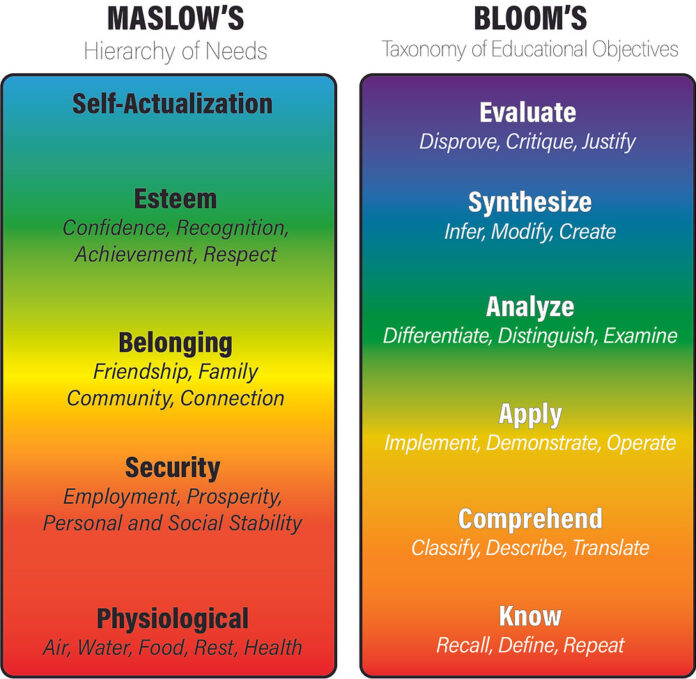Can a hungry student focus on learning? First he or she needs to cope with hunger and then engage in academic learning. The same goes for a neglected or terrified student. Maslow before Bloom means that basic human needs must be satisfied before learning can take place.
Pakistan has an estimated 22.8 million out-of-school children. And, unfortunately, of those fortunate children who can attend school, many have to struggle with learning in the classroom. There may be a variety of reasons for their predicament. However, in Maslow’s view, to open the brain of a student to learn new things, they must first have their most basic needs met.
Benjamin Bloom and Abraham Maslow were two 20th-century American psychologists. Bloom is famous for developing Bloom’s taxonomy, a classification of educational objectives into different learning domains. Teachers frequently use Bloom’s taxonomy for lesson planning and creating goals and objectives. Maslow is remembered for his well-known theory of the hierarchy of needs that influences a person’s motivation to succeed. The hierarchy places human needs on five ascending levels: physiological needs, needs for safety and security, belongingness needs, esteem needs, and the need for self-actualization. Maslow believed that basic needs must be met before higher-level needs can be addressed.
The hierarchy of needs begins with physiological needs. These are priority needs and refer to the most urgent essential elements needed for biological survival. Physiological needs include food, drink, sleep, shelter, optimal temperature, and the like. A learner cannot focus on learning if their physiological needs are not satisfied. A sleepless student would fall asleep in the classroom. And a thirsty student would naturally prioritize thirst over education.
Teachers need to gain insight from Maslow’s theory of hierarchy of needs. They should make space for cognitive availability for learning, create ample opportunities, and adapt instruction to meet students’ needs. And lastly and most importantly, teachers must understand that students’ basic needs must be met before they can climb Bloom’s taxonomy for critical thinking and learning.
Once physiological needs are met, students go to the next level of the hierarchy, known as safety needs. Safety needs mean security, freedom from harm, and protection from potentially dangerous objects and situations. Learning cannot occur if a classroom or school environment is fearful and threatening. On the other hand, a secure and inviting environment enhances student engagement in learning. Moreover, if the teacher does not accept a student or they are mocked or bullied at school, their primary focus will not be on education but on acquiring safety.
Belonging needs constitute the third level of Maslow’s hierarchical ladder of needs. The needs for affection, love, trust, and acceptance are called belongingness needs. This level emphasizes a person’s need to be identified as part of a family, clan, community, and so on. Loneliness and isolation may hinder learners from achieving learning gains. However, a sense of belongingness, affection, and trust can do miracles. The secure attachment of students with teachers and peers has been observed to yield higher academic performance, reduced problem behaviour, and better attendance.
Esteem needs represent the fourth level in the hierarchy. There are two aspects of esteem needs. One set of needs represents self-respect and feeling about the self. The second set is concerned with the need for respect from others. For a student, esteem needs refer to positive classroom culture. If esteem needs are not satisfied, the students may suffer from disengagement and poor focus and show changes in behavioural patterns. They will feel unimportant and incompetent. The teachers should regard their students as unique individuals, provide positive feedback, and genuinely appreciate and acknowledge their achievements.
Self-actualization, the fifth and the highest level, is the pinnacle of Maslow’s hierarchy of needs. This level concerns a person’s motivation to attain full potential as a human being. Maslow initially believed that very few people could achieve self-actualization, but later, he expanded the concept to encompass everyday people.
It is pertinent to note that Maslow’s hierarchy of needs has not remained static. It has evolved from five levels to seven or eight levels over time.
The hierarchy’s lower four levels (also known as deficiency needs) must be the primary focus of school teachers as these play a decisive role in a student’s academic success. It is unfair and discriminating to label students as apathetic or unintelligent when they arrive at school unprepared for learning. They may have problems at home. They may have certain basic needs unsatisfied. The teachers should see beyond the classroom to seek detailed answers and reasons for the student’s lack of interest and poor performance.
Maslow’s theory of hierarchy of needs has its strengths and weaknesses. However, one thing is for sure it has immensely influenced educators’ thinking worldwide, which is why it is prevalent in education spheres. It is a motivation theory and accurately tells us how the students are motivated to learn. It gives us a universal understanding of the complexity of human needs. Moreover, we can get a view of the whole student thanks to Maslow.
In short, teachers need to gain insight from Maslow’s theory of hierarchy of needs. They should make space for cognitive availability for learning, create ample opportunities, and adapt instruction to meet students’ needs. And lastly and most importantly, teachers must understand that students’ basic needs must be met before they can climb Bloom’s taxonomy for critical thinking and learning.






















